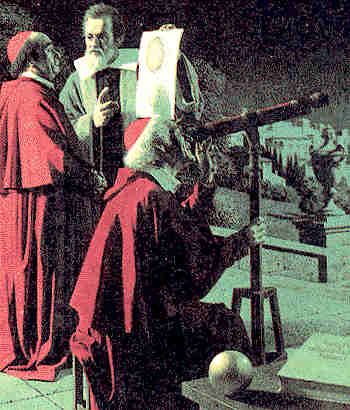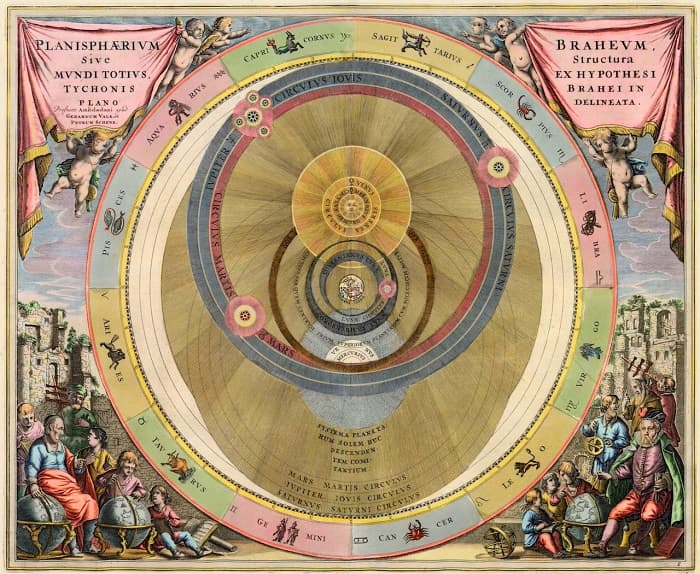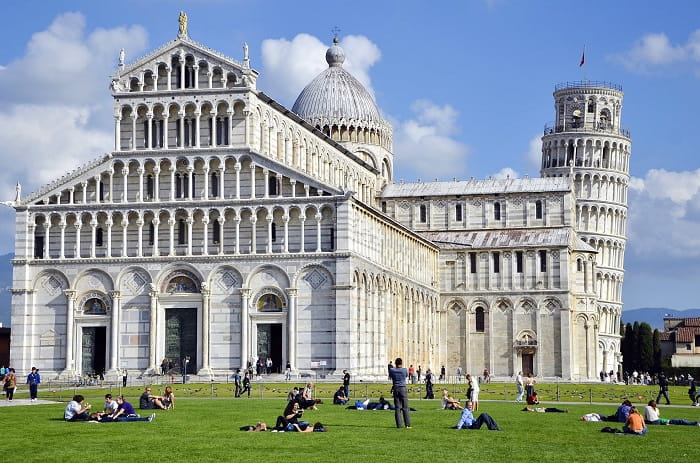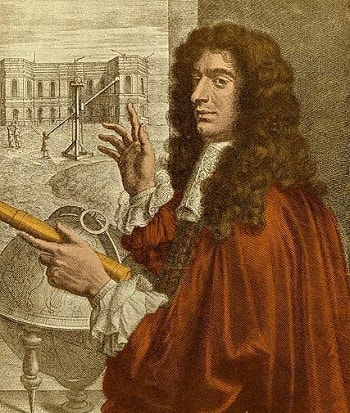When astronomer Galileo Galilei turned his newly built telescope into the sky on January 7, 1610, he saw a light spot that slowly traveled through the clear night over the city of Padua, Italy. This was the point he was looking at: the planet Jupiter. In amazement, he realized that “all four little stars” accompany the planet. These were actually the moons orbiting the giant planet.
Galileo Galilei’s first telescope

The landscape he saw was against the traditional understanding of the Church, which assumed that all the objects in the sky revolved around the Earth. Galileo’s discoveries would change the way the Church thought about the universe in a revolutionary way.
Traditional beliefs about the nature of the universe were rigid and had been in place for a long time. For 300 years, the Catholic Church and universities accepted the Ancient Greeks’ theories, particularly those of Aristotle and Ptolemaios: the Earth is stable in the center of the universe, and other objects in the sky revolve around it. Since no one could see the roughness of the moon, planets, and stars, their models were considered to be perfect circles, the most flawless of shapes.
The church has adopted the perspective of the ancient age in terms of supporting its mission to help sinful humanity turn towards divine perfection. Two beliefs supporting this view were vital. First, the sky should always be considered perfect. Second, the world in which humans live should have been the constant center of everything, as the focal point of divine creation. Theories put forward by Aristotle and Ptolemy, which support this understanding, gradually became religious dogma.
By the time Galileo lived, this dogma had lost some of its former strength. Polish pastor and mathematician Nicolaus Copernicus suggested in 1543 that the motion of the planets could be more easily explained if the Sun were considered to be the center of everything. Giordano Bruno was burned at the stake in 1600 due to his religious convictions (one of which was the insistence that the Earth was orbiting the Sun). In short, Galileo knew what he was facing.
The third telescope

Galileo began his work at the age of 18 in 1582, which would later help shape various basic laws of motion. In 1609, while teaching mathematics in Padua, he came across the name of Dutch spectacle-maker Hans Lippershey, who created two primitive telescopes by combining two lenses in a tube. Galileo made himself a telescope that could magnify objects only three times. He made a second telescope in a few months and then magnified it 32 times. It was this third telescope that he used to study the sky in 1609-1610.
The discoveries quickly followed one another, each a challenge to the teachings of the Church. The lunar surface wasn’t perfect. There were craters, mountains, and plains. The Sun, which was regarded as “untainted” until then, had spots, and Jupiter also had moons that did not rotate around the Earth, and Venus could not be seen unless it revolved around the Sun rather than the Earth. And many previously unknown stars could now be observed.
In short, Galileo’s telescope provided convincing evidence that we live on a planet that revolves around the Sun, not at the center of the universe. Copernicus was right, and the Church’s doctrine on this subject was wrong, as Galileo clearly showed in Sidereus Nuncius (Starry Messenger or Sidereal Messenger), which he wrote in 1610.
The war lost by the Church

Based on the detailed observations of German astronomer Johannes Kepler (1571-1630), a colleague of Danish astronomer Tycho Brahe (1546-1601), it could be seen that the planets were not following an elliptical circle but rather ellipses. Kepler designed three laws to explain the speed and orbit of a planet, thereby supporting the theories of Copernicus and Galileo. But it was still not easy for Galileo to prove that the Earth was moving. In 1615, the Church responded to the challenge.
The Pope stated that the doctrine that explains the Sun as the central and fixed figure was “false, absurd, and formally contrary to religious belief and the Bible.” Galileo was informed that he should change his views. He withdrew from public life until 1632, and that year he made a dangerous comeback with the book Dialogo sopra i due massimi sistemi del mondo (Dialogue Concerning the Two Chief World Systems), which supported Copernicus’ idea.
Galileo was ordered to return to Rome in 1633 and retract his words because he opposed religious belief. He did so because he was threatened with torture, but it was rumored by some that he murmured “E pur si muove” (And yet it moves). Galileo was actually under house arrest until his death in 1642, but he could not prevent the spread of his ideas. The religious imposition was beginning to unravel in the face of science. But in 1992, it would take 359 years for Pope John Paul II to consider Galileo’s conviction as “tragic mutual incomprehension.”
When did we start observing the sky?

Since the ancient Babylonian civilization, that is, approximately 2000 BC, the sky has been explored not for objective information but because it is believed to control people’s lives. It was evident that the Sun and the Moon were linked to human life as they managed the seasons and tidal events; therefore, people worshiped them as gods. Other celestial bodies were also seen as divine beings with their own special powers over humans. Thus, it was thought that the information in the stars must have been the information of the future. Mystical beliefs and practical knowledge were increasing together. Astronomy and astrology were the same thing in the Old World.
Babylonians, Egyptians, Greeks, and Chinese have long had a tradition of observing the sky. The Babylonians were able to calculate the length of a year with an error of four and a half minutes, but in all these cultures, astronomy was considered a means of supporting astrological prophecies. It was the Babylonians who designed the signs of the zodiac that are still in use today by astrologers. Ptolemy’s geometric universe depiction based on circular movement was the main theory of his work, The Almagest. Ptolemy argued that behavior, height, appearance, and even national character traits of humans could be read from the stars.
The belief in the prophetic power of the stars survived after the emergence of Christianity and eventually experienced a great resurrection in Medieval Europe. Though his meticulously crafted catalog of stars would play a crucial role in proving that astrology was not a science, Tycho Brahe still believed in the reality of astrology. Tycho’s student, Johannes Kepler, also made his living by preparing horoscopes.
But Brahe, Kepler, and Galileo’s works provided proof that astronomy was a science that looked into the universe and had a different purpose than astrology.
How did Galileo first start researching?

The origin of Galileo’s research is based on an event that occurred while he studied medicine at Pisa University. While looking at a lamp swinging from the ceiling of a church, he realized that even if the swinging distance was shortened, the back and forth movements always seemed to be of the same length. Seven years later, while teaching mathematics, he proved that the time it takes for a pendulum to complete its swing remains the same regardless of how much up or down it swings. The duration changes only when the length of the pendulum changes.
Galileo also found that altering the weight of a pendulum did not make a difference in timing, in complete contradiction with Aristotle’s discrete “law” that heavy objects fall faster. In later experiments with balls rolling down prone surfaces, he discovered that falling objects always accelerated in the same way, which was not related to weight.

A new generation of people emerged after Galileo’s death, improved his two main scientific tools (the telescope and pendulum clock), and significantly expanded the revolution he started. Galileo’s small telescope could magnify 32 times. Astronomers continued their experiments in the mid-XVII century with 11.9 ft (3.6 m) long and 50-times magnifying equipment, and some even had 200 ft (60 m) long giant devices. Meanwhile, telescopes were inserted with new devices to calculate the position of the stars and the size of the planets.
Galileo also suggested that pendulums could be used to adjust clocks. The use of pendulums resulted in a striking improvement in the management of the clocks. For the first time, clocks could measure both minutes and seconds and the duration of the movement of celestial bodies. More discoveries were made later. Johannes Hevelius, a Polish scientist, mapped the Moon. In the Netherlands, Christiaan Huygens discovered that it was Saturn’s rings that changed the way the planet appeared. An Italian named Giovanni Cassini spotted a giant stain in the atmosphere of Jupiter and discovered that it took 9 hours and 56 minutes for the planet to spin around its axis.
The telescope and the pendulum clock were combined in a brilliant experiment in 1670. Two astronomers, Cassini, who lives in Paris, and Jean Richer, from French Guiana, simultaneously measured Mars’ position. Since there was a distance of about 4,000 miles (6,400 km) between the two people, the images appearing in both astronomers’ telescopes were slightly different due to Mars’ relative position to the fixed stars in the background. This difference made it possible for Cassini to calculate the distance between Mars and Earth.
Thus, Cassini had a measuring rod that made it possible to measure the distance from any planet or the Sun. He calculated the distance of the Sun as 87 million miles (140 million km), and his error was only 6%. For the first time, man was learning not only the structure of the solar system but also its incredible dimensions.
The development of science after Galileo
The telescope has revealed a new world to explore, and while this has allowed us to find answers to some questions, it has also created many new ones. The most important of these questions was: Why were the Earth, other planets, and moons following a rotation like this? Galileo’s telescope and subsequent improved models showed that the sky was somewhat like Earth, with material objects directed by the same rules. This discovery was the basis for a major revolution in astronomy that would result in Isaac Newton’s works, a generation after Galileo’s death.
The atmosphere of thought that prevailed in England in the middle of the 17th century was very different from that in Italy. Since they did not have to fight the impositions of the Church, British scientists had great freedom to experiment and develop theoretical science.
In 1665, Newton analyzed the nature of light at his home in Lincolnshire, Woolsthorpe. He then invented a powerful mathematical tool, an amazing calculation method that investigates the rate of change in quantities. It was the first time he began to understand the power that controlled the movements of celestial bodies, but it would take another 20 years for his findings to be published in his book Principia Mathematica (Principles of Mathematics).
Here he first describes the force of gravity. Objects attract each other with a force proportional to their mass. This power decreases in inverse proportion to the square of the distance between them. In other words, doubling the distance reduces gravity by a quarter. Behind Newton’s mathematics lies an insight into the intriguing simplicity that existed when Newton simply saw an apple falling in the garden by the force of gravity.
This phenomenon is so well known that its reality can be seen as suspicious. However, the story is true, even if it didn’t actually fall on the scientist’s head. The same rules govern apples, moons, pebbles, and planets. The law of gravity is universal and can be defined in the language of mathematics. This was Galileo’s true legacy.
Galileo and the Leaning Tower of Pisa
A story that is always told says that Galileo dropped two spheres of different weights and sizes from the top of the Leaning Tower of Pisa, and he saw them fall at the same speed and reach the ground at the same time. But there is no record that this experiment was really done. Even so, it would be difficult to observe and correctly evaluate the results.
All objects tend to fall at the same speed in a vacuum. But in an environment with air, the rate of the decline reflects the complex relationships between the density and size of objects. Small objects fall slower than larger ones, even if they are made of the same material, because they have a larger surface area than their weight. A mouse can survive a fall, which can shatter a horse. Pendulums and inclined planes were undoubtedly more reliable scientific research tools.
Bibliography:
- Sharratt, M. (1994). Galileo: Decisive Innovator. Cambridge: Cambridge University Press. ISBN 978-0-521-56671-1.
- Drake, S. (1973). “Galileo’s Discovery of the Law of Free Fall”. Scientific American. 228 (5): 84–92. Bibcode:1973SciAm.228e..84D.
- Drake, S. (1990). Galileo: Pioneer Scientist. Toronto: The University of Toronto Press. ISBN 978-0-8020-2725-2.
- Shapere, D. (1974). Galileo, a Philosophical Study. University of Chicago Press.
- Shea, W. R. & Artigas, M. (2003). Galileo in Rome: The Rise and Fall of a Troublesome Genius. Oxford: Oxford University Press. ISBN 978-0-19-516598-2.
- Sobel, D. (2000) [1999]. Galileo’s Daughter. London: Fourth Estate. ISBN 978-1-85702-712-9.

